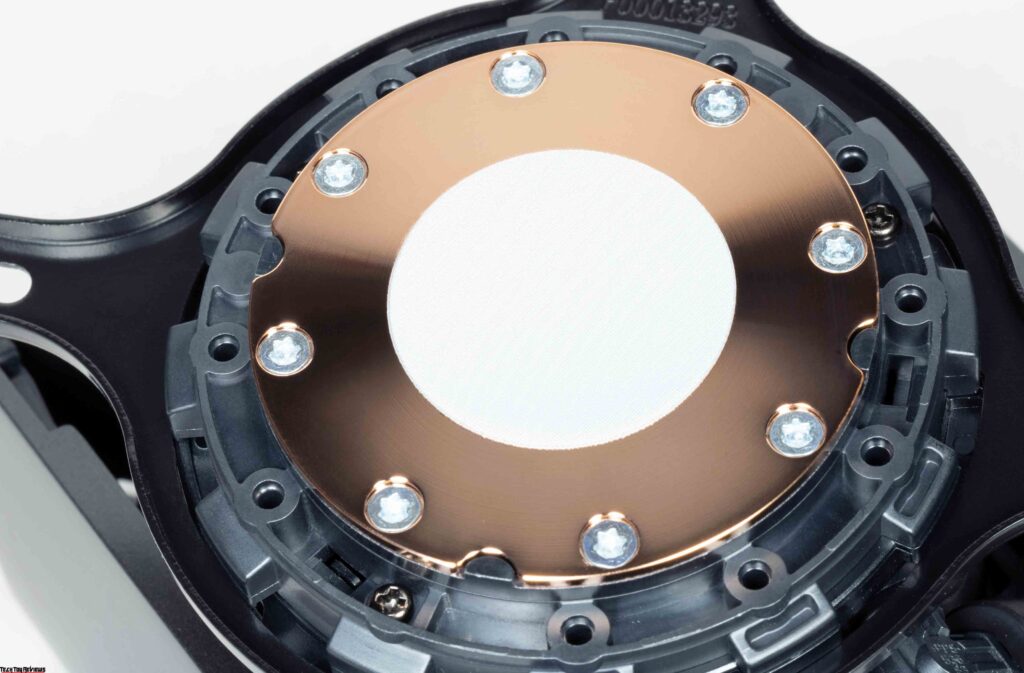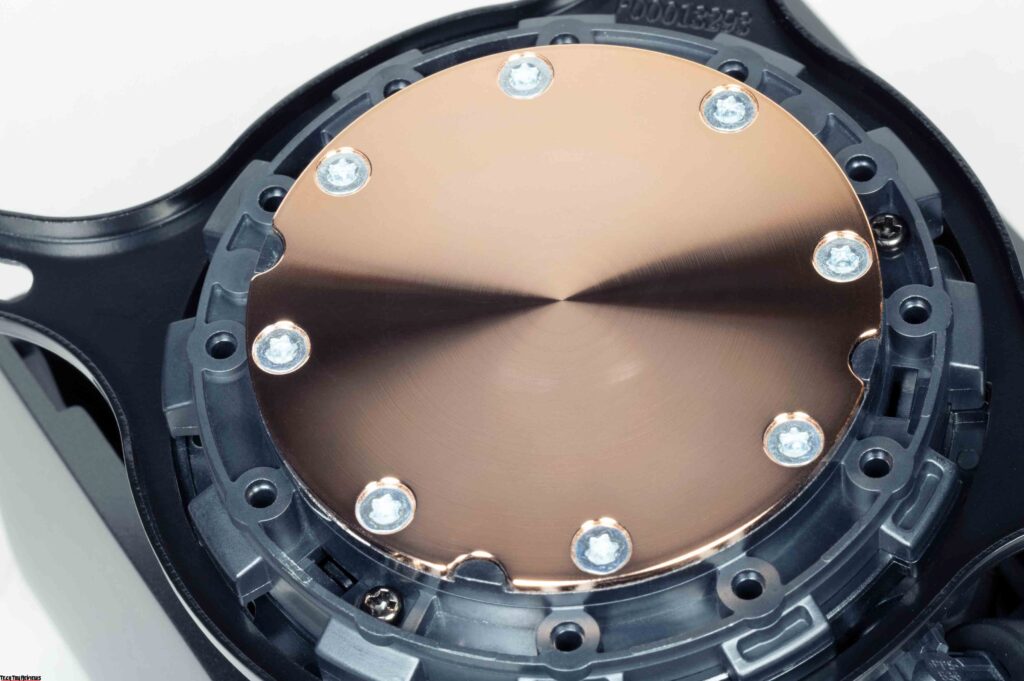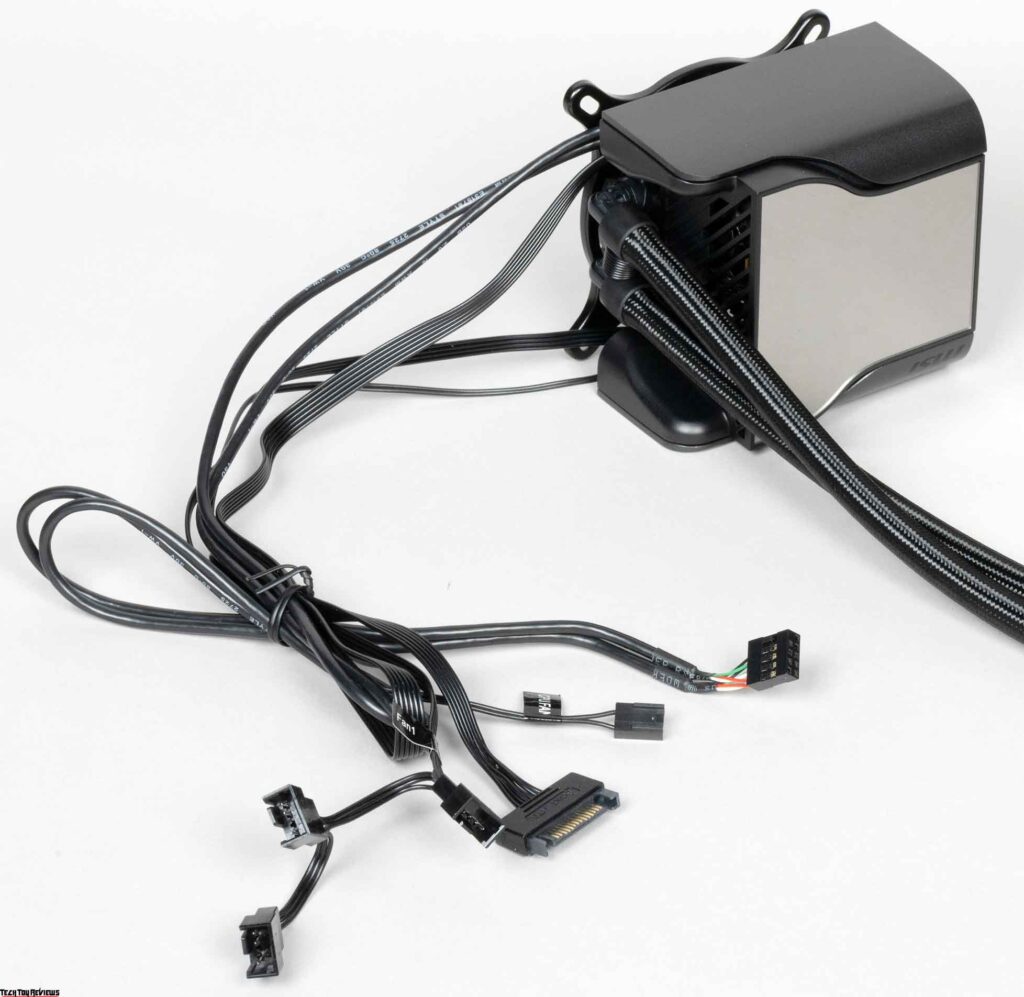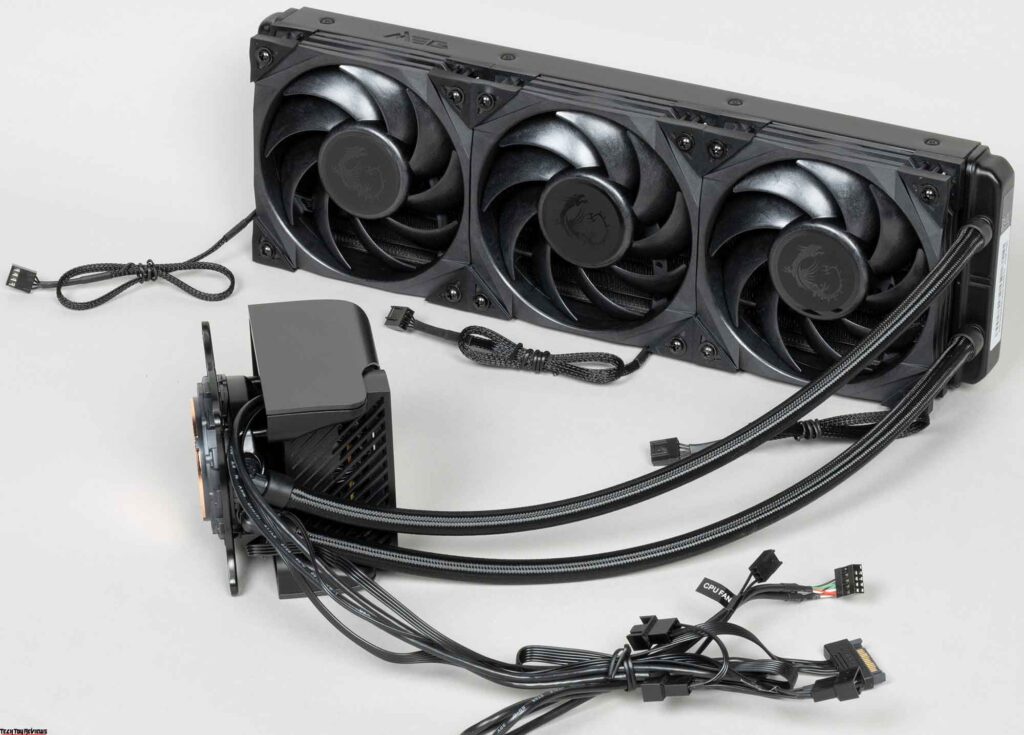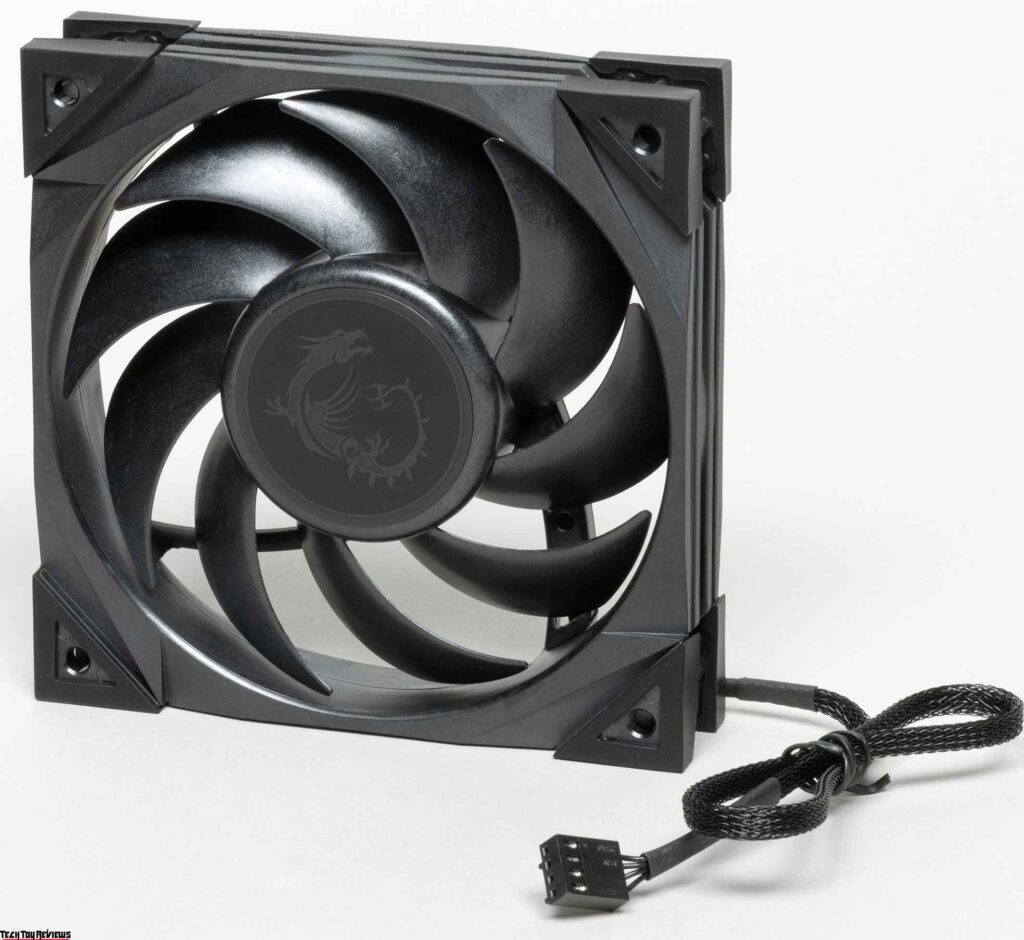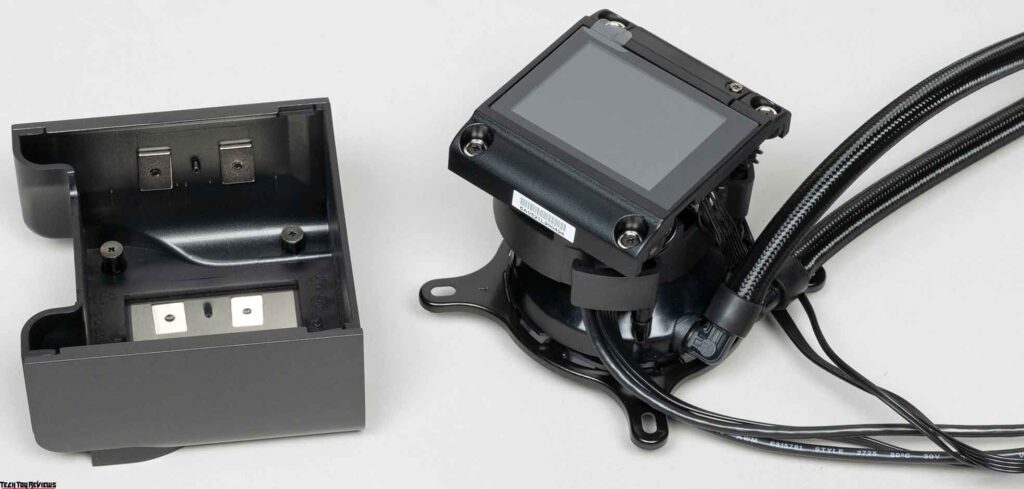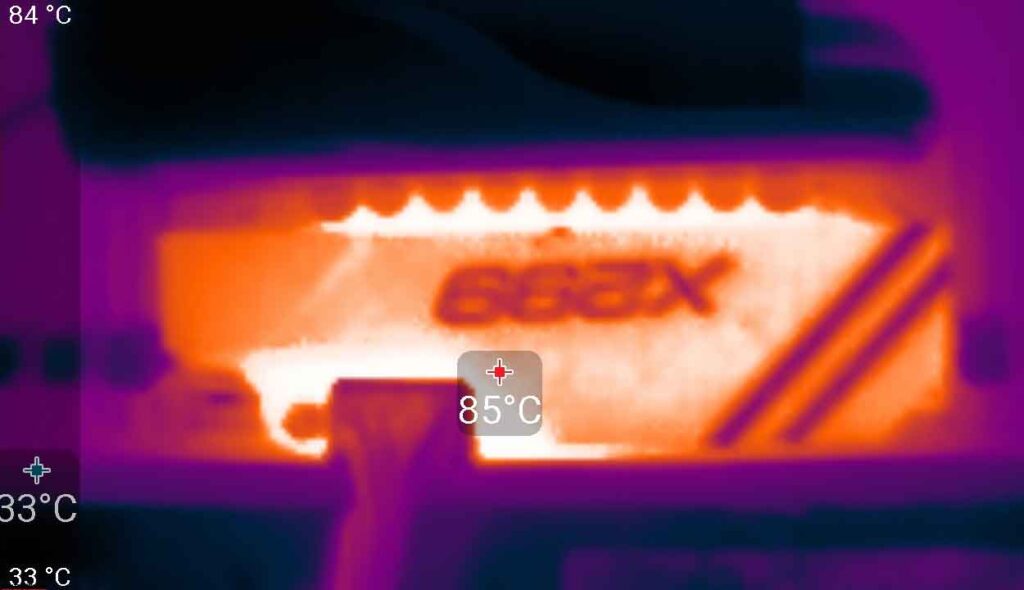The MSI MEG CoreLiquid S360 liquid cooling system is supplied in a stylishly designed corrugated cardboard box. The outer bottom of the box depicts not only the product, rather some features (with text and pictures), as well as the technical specifications are also listed. The sole of the heat sink is protected by a rigid plastic casing, and the screen and sight glass on the pump is protected by plastic foil.
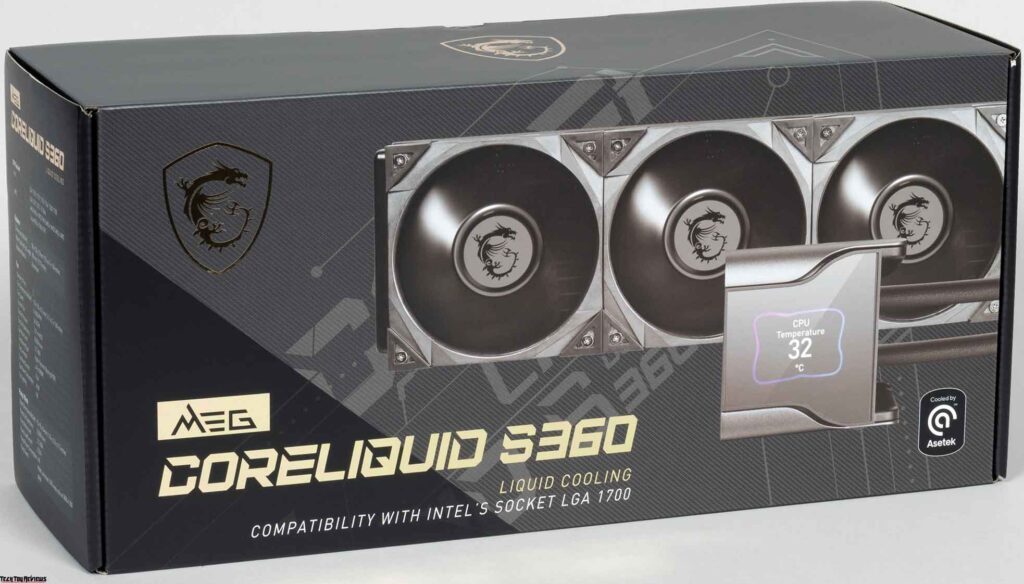
Inside the box
Inside the box is a radiator with a connected water block, fan, a set of fasteners, and installation instructions.
The instruction is of good print quality and is mainly in pictures. The company’s website has a complete description of the product and links to PDF files with instructions and technical data.
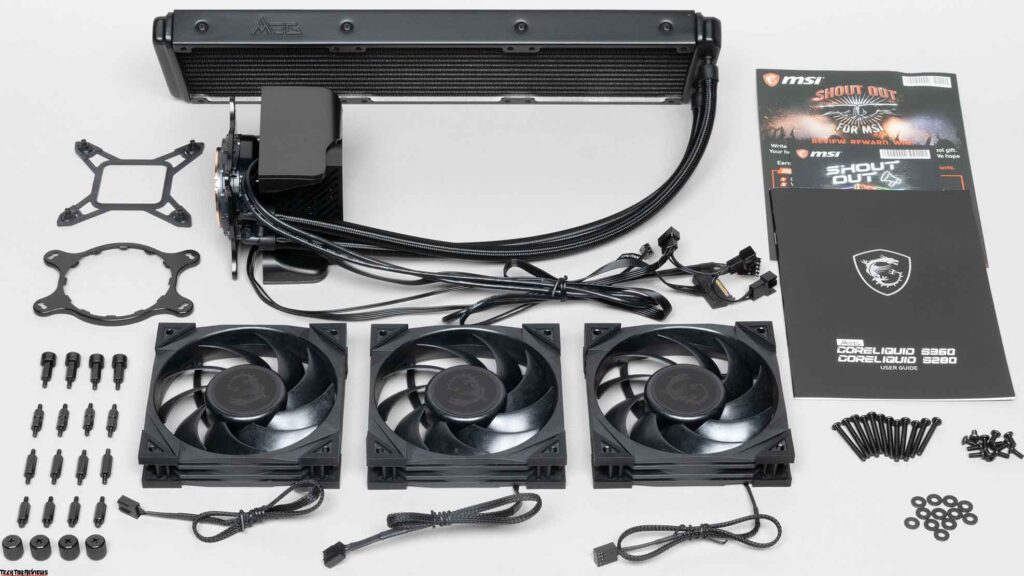
The MSI MEG CoreLiquid S360 system is sealed, pre-charged, and ready to use. The pump is integrated with the heat sink in a single unit. The sole of the heatsink, directly adjacent to the processor cover, is a 1.5mm thick copper plate. Its outer surface is ground and slightly polished. Towards the center, the surface is convex with a gap of about 0.2 mm.
Design
The outer diameter of this plate is 54.5 mm, and the diameter of the inner part surrounded by holes is 43.5 mm. The central part of the copper base has a thin layer of thermal paste. Unfortunately, there is no reserve for its restoration in the delivery set.
All tests used quality thermal paste from another manufacturer. Looking ahead, we will demonstrate the distribution of thermal paste after all tests are completed. On Intel Core i9-7980XE processor:
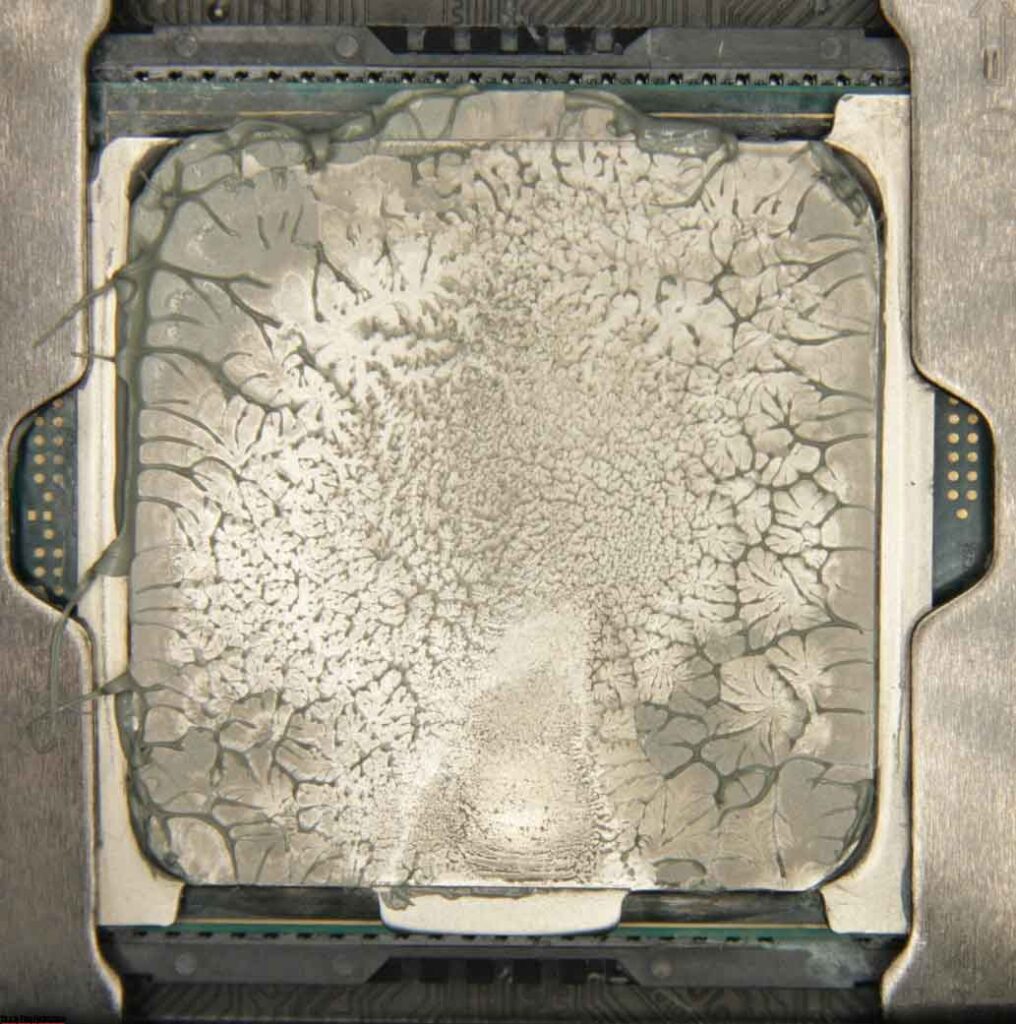
And on the bottom of the waterblock:
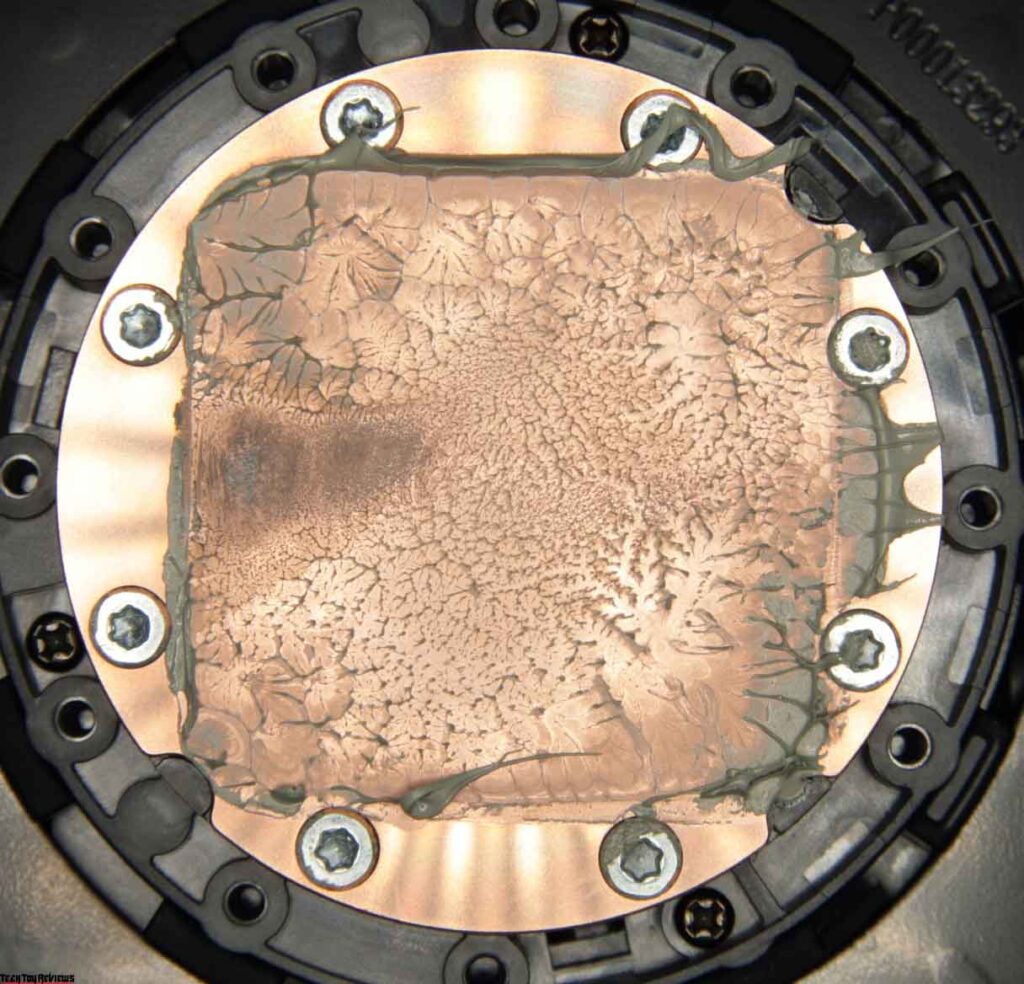
It can be seen that the thermal grease is distributed over the entire area of the processor cover, and almost in the center there is a large area of tight contact. Note that the lid of this processor itself is slightly convex towards the center. On AMD Ryzen 9 3950X processor:
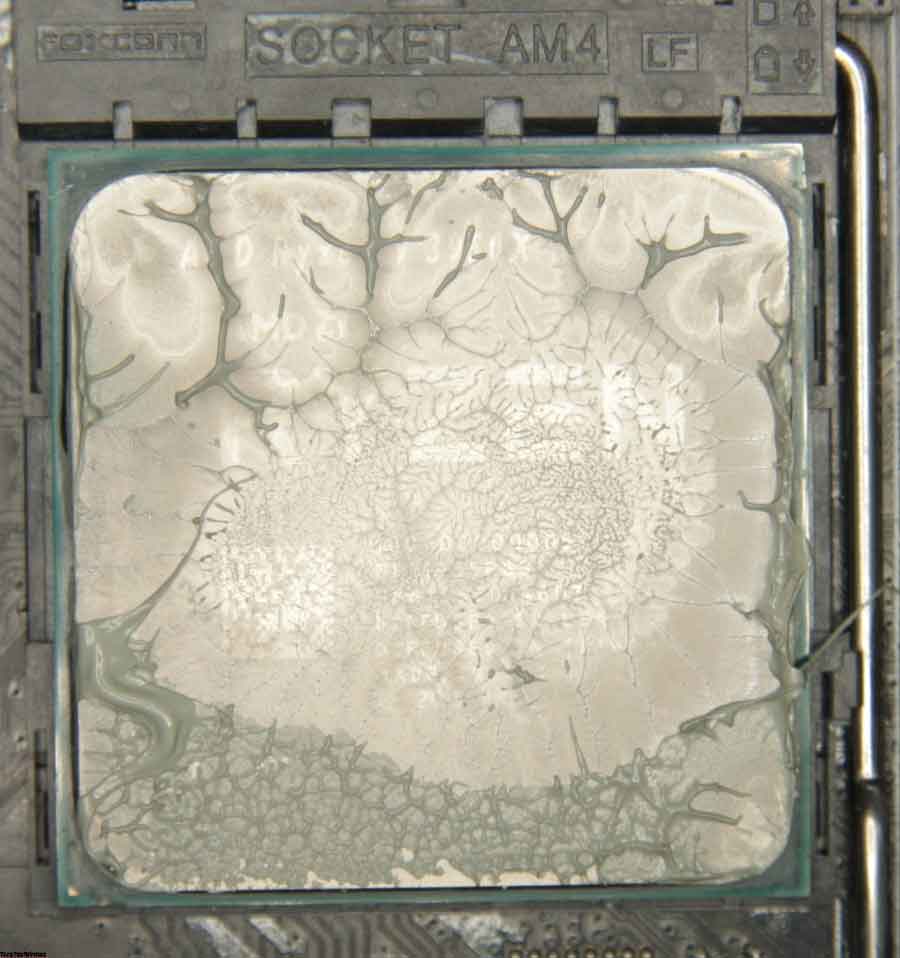
On the sole of the heat sink:
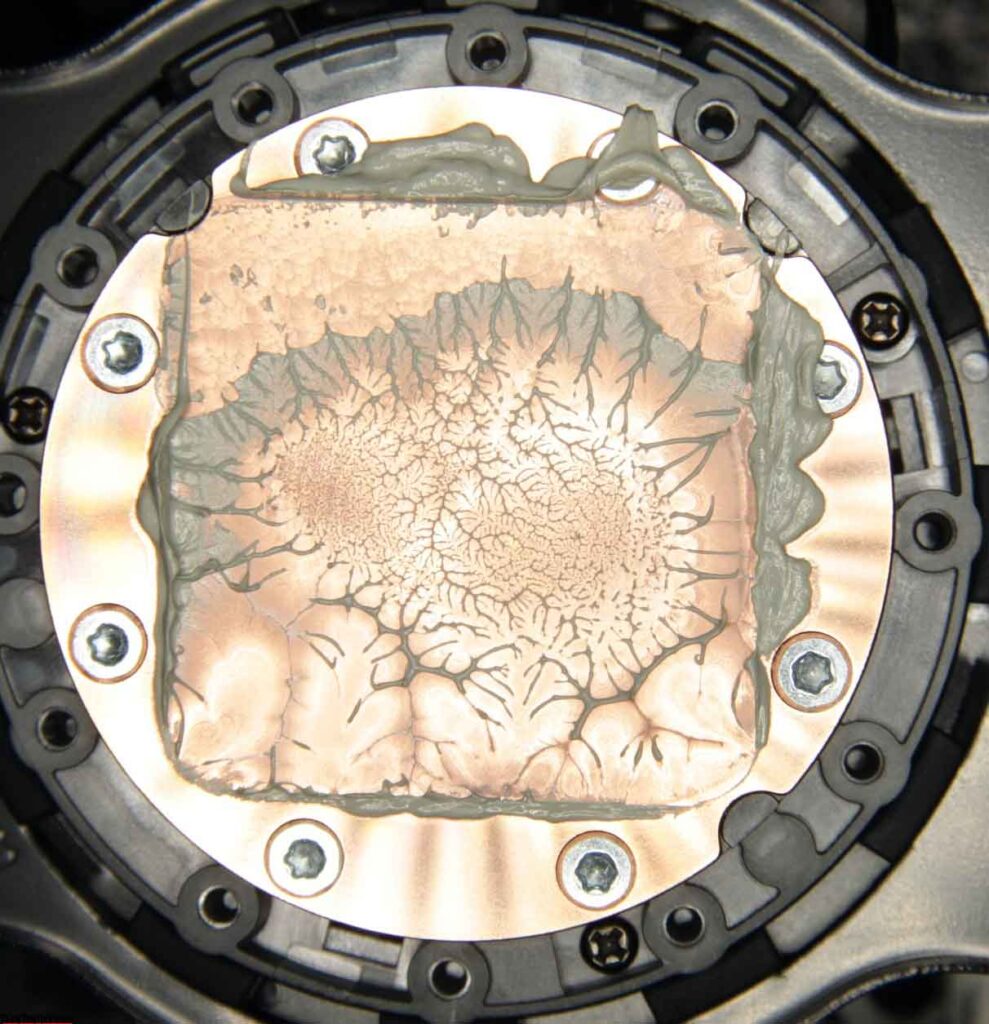
The situation is almost the same. (The distribution of thermal paste, of course, changed slightly when the processor and pump were disconnected.)
The body of the Waterblock is made of hard black plastic. On the top of the case, the pump casing is fixed first, then the fan, then the control and management board, and this sandwich is accomplished by an LCD screen with its casing. The surface of the screen itself is slightly matte, it is protected by a mineral glass plate with an air gap between it and the screen. But that’s not all – a plastic cover is placed over the pump, which is held in place by magnets. This cover has a mineral glass viewing window with a metalized surface, so it is a translucent mirror. This cover serves as a decorative function and directs the flow of air from the fan to the right places. The design is completed by specially made decorative side plates made of aluminum alloy with an anodized silver-dark gray semi-matte surface. They are also fixed with magnets.
The hoses are enclosed in a slippery synthetic sheath. The outer diameter of braided hoses is about 11 mm. L-shaped fitting on the pump inlet swivels to facilitate installation of the system. The radiator is made of aluminum and has a matte black coating on the outside.
Rubber pads are installed at the corners of the fan frame. In theory, these elastic elements should reduce noise from vibration, but in practice, none of this will happen, since the mass of the fan and the stiffness of the vibration damping elements make it possible to reasonably assume the cause of the high resonance. The liquid cooling system would in no case have any significant anti-vibration properties.
Fasteners are primarily made from hardened steel and have a durable black semi-matte paint finish. The frame behind the motherboard is made of durable plastic and equipped with a steel threaded socket in the movable insert. Compatibility with the Intel LGA 1700 socket is ensured by special stands and the ability to adjust the pitch of the mounting holes. We note the convenient bayonet mount of the pump frame, as well as the large pointed nuts, which allows you to do without tools when installing the pump. The mass of the system assembled with fasteners for LGA 2011 is 1604 g.
The pump has a built-in fan to cool the voltage regulator unit (VRM) and other components around the processor. It is believed that the use of LSS with conventional water blocks can reduce the stability of the system due to overheating of the VRM, as in the case of installing LSS, unlike air coolers, these blocks are cooled even worse. Of course, another fan increases the noise level and reduces the overall reliability of the system, but it can be turned off in extreme cases.
Practical test
Let’s do a practical test. First, heat the VRM well to a constant temperature (see description of the load below). Then we block the fan on the pump and again wait for a stable temperature, see how much the temperature of the VRM heatsink rises.
And to control it, turn on the fan again:
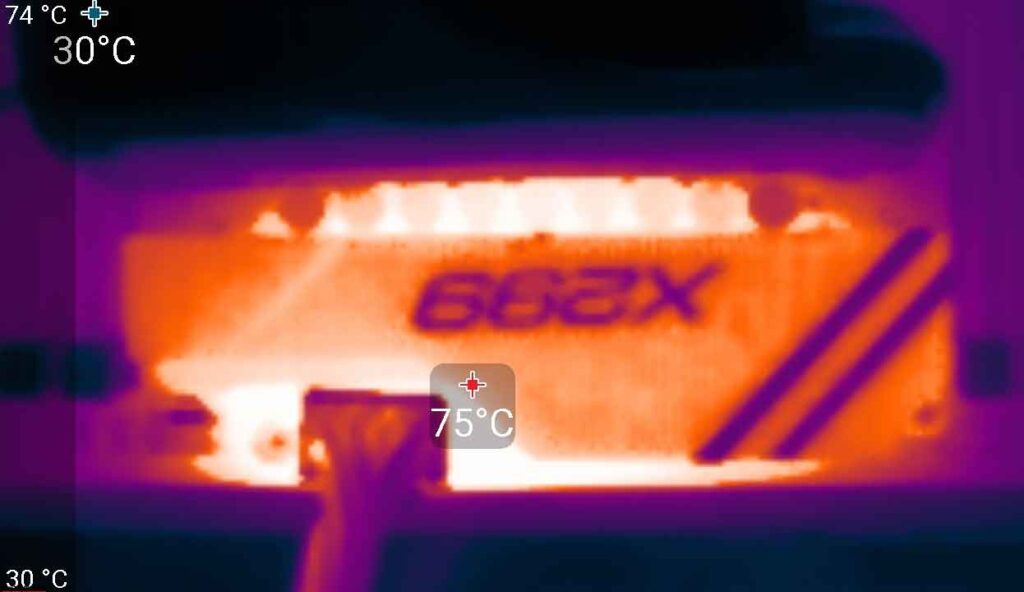
In the first test, the temperature dropped back to the value. In this case, the effect is to lower the temperature by 10 degrees, which is great.
Another feature of this LSS is the presence of an LCD screen. For the screen to be useful, the pump must be connected to the USB connector on the motherboard (note that not all have this connector), and the MSI Center software must be installed on the PC. The functionality of this software related to this system is that the user can monitor the current values of the fan speed on the radiator and on the pump and rotor of the pump itself, choose from the available (three profiles) or create your own. The fan and pump speed depend on the temperature of your processor.
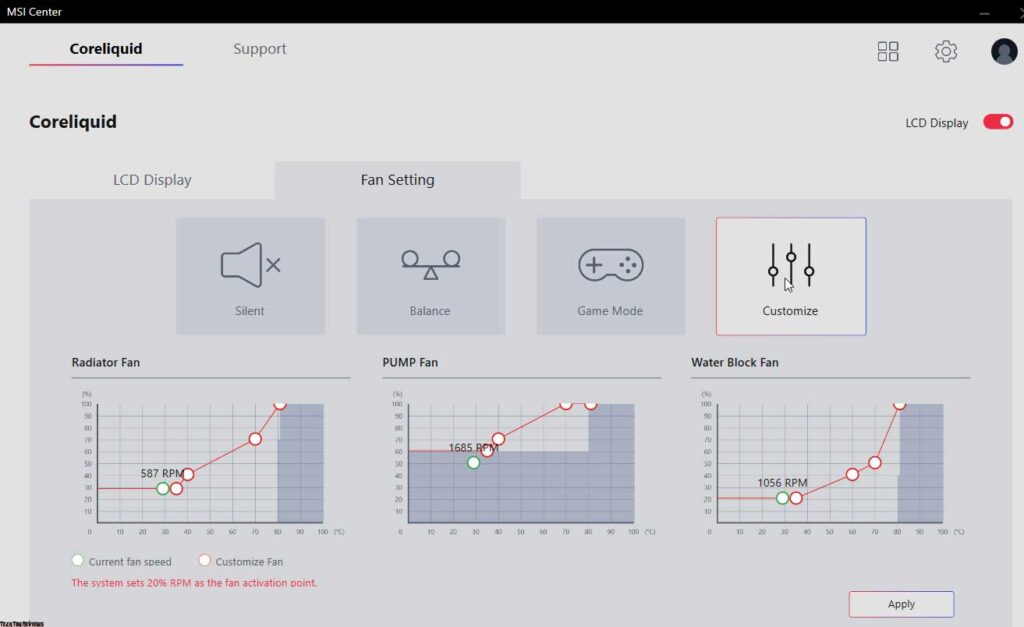
On the pump screen, you can display the temperature and rotation speed from several sensors (cyclic change of readings):
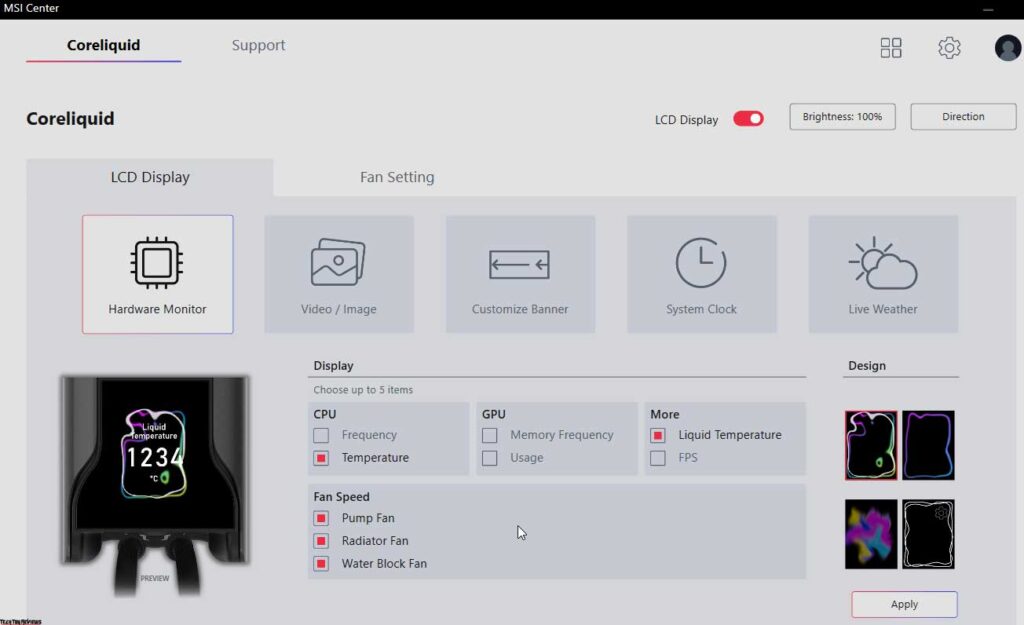
A static or dynamic splash screen.
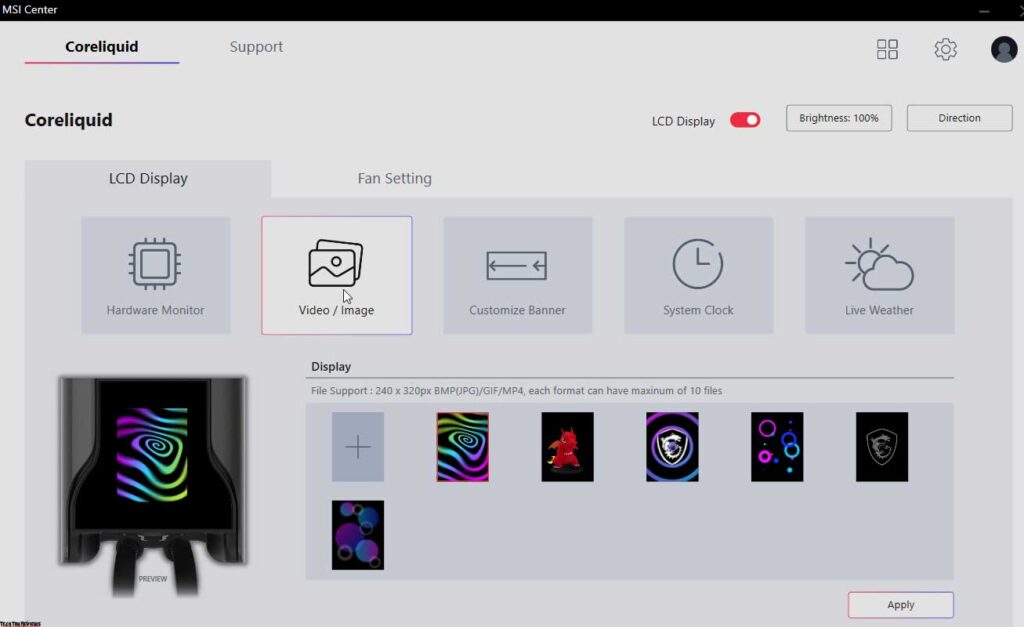
You can also set the background:
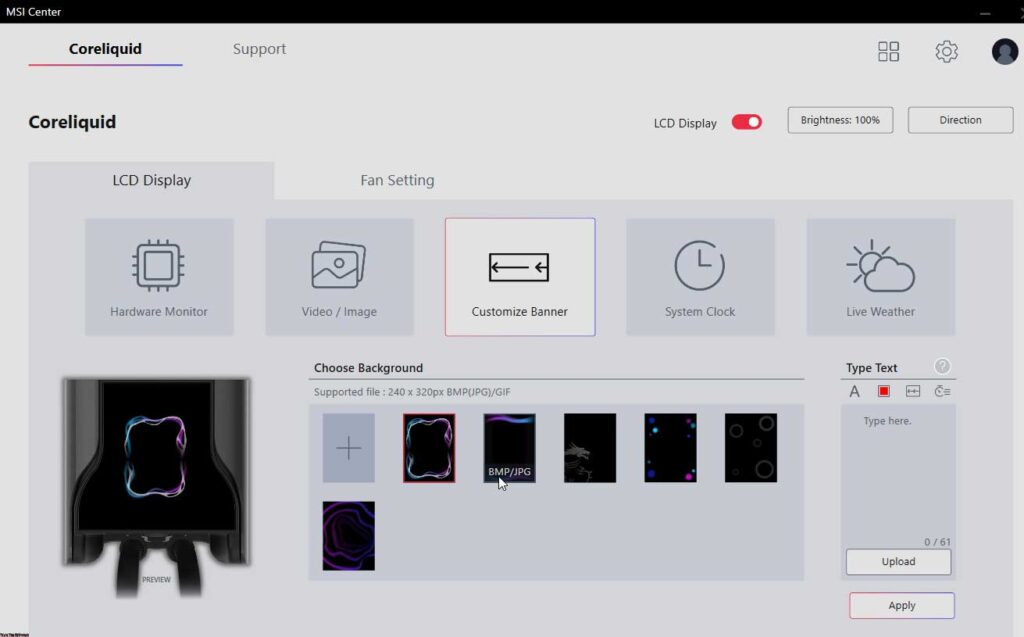
Display system frequency:
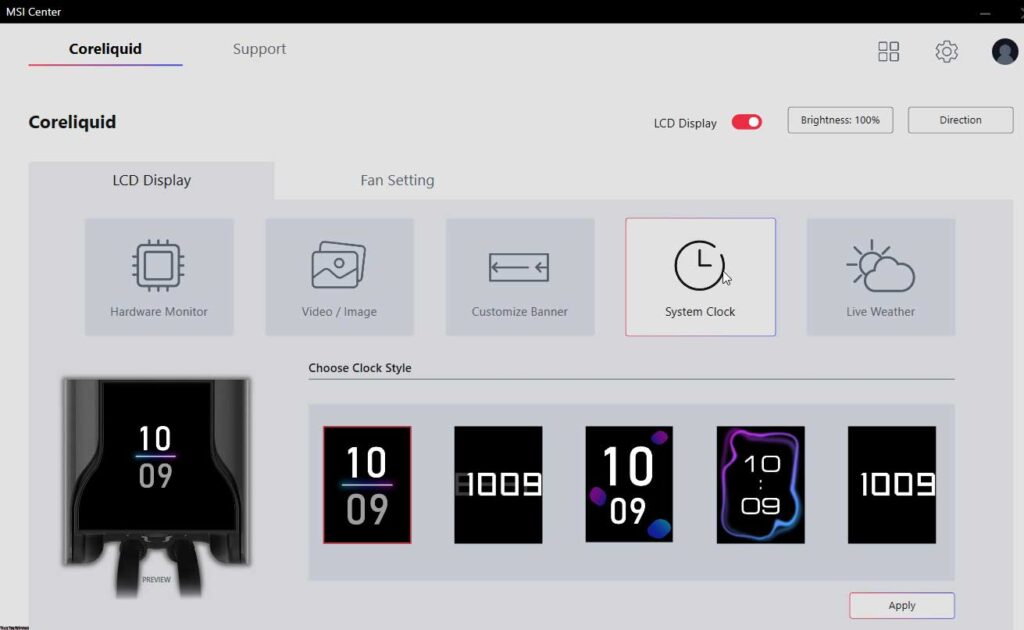
And weather data (it didn’t work for us):
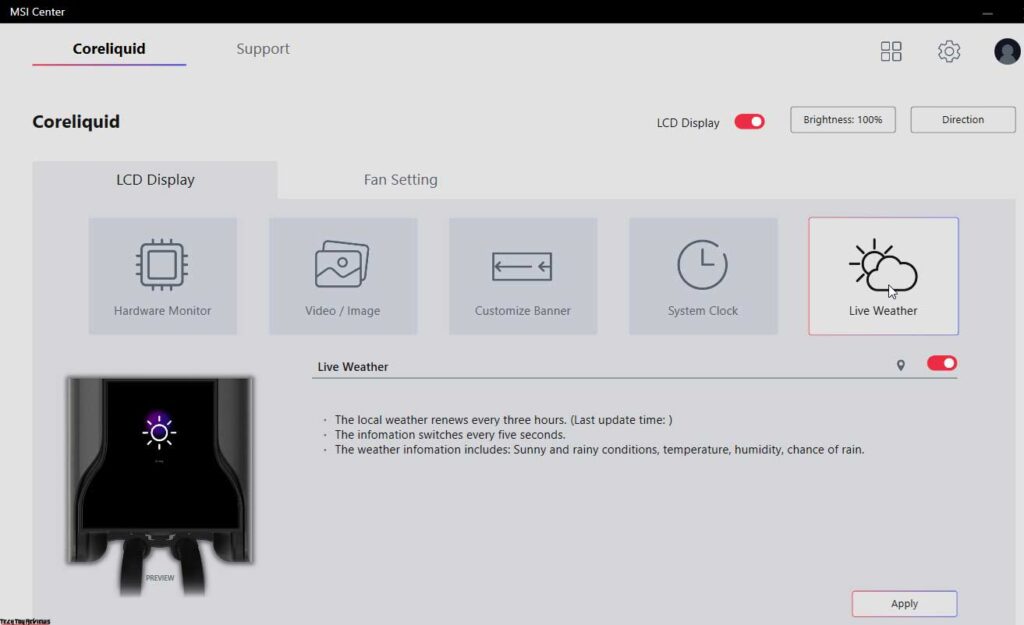
MSI MEG CoreLiquid S360 specifications
- Cooling system type: Liquid closed type pre-filled non-expandable for processor
- TDP: No data
- Compatibility: Intel: 1150/1151/1155/1156/1200/ 1700 2011 / 2011-3 / 2066;
- AMD: AM4 / FM2 + / FM2 / FM1 / AM3 + / AM3 / AM2 + / AM2 and TR4 / sTRX4 / SP3 *, * frame included with processor
- Fan type: axial (axial), MEG Silent Gale P12 (PLA12025S12H-4), 3 pcs.
- Fan power: 12 V, 0.36 A, 4-pin connector (common, power, rotation sensor, PWM control), 350 mm cable
- Fan dimensions: 120 × 120 × 25 mm
- Fan speed: 0-2000 rpm
- Fan performance: 95.5 m³ / h (56.2 ft³ / min)
- Fan static pressure: 21.7 Pa (2.21 mm H2O)
- Fan noise level: 22.7 dBA
- Fan bearing: Hydro-Dynamic Bearing
- Fan service life: 50,000 h
- Radiator dimensions: 394 x 120 x 27 mm
- Radiator Material: Aluminum
- Hose length: 400 mm
- Hose material: Plastic (PVC) with braid
- Water pump: Integrated with heatsink, equipped with a VRM cooling fan
- Pump power: 0.33 A, 4 W, connect to SATA power connector from PSU (common, power supply 12.5, and 3.3 V)
- Pump rotation speed: 2800 rpm
- Pump noise level: 21.2 dBA
- Waterblock dimensions: 95 × 95 × 54 mm
- Heat sink material: Copper
- Heat sink thermal interface: Applied thermal paste
- Pump life: 50,000 h
- Connection: PUMP – to the 3 (4) -pin (common and rotation sensor) connector for the CPU cooler on the motherboard (350 mm); to the SATA power connector from the PSU (general, power supply 12, 5, and 3.3 V) (615 mm); to the internal USB 2.0 connector on the motherboard (two ports, 700 mm). / FANS – pin connectors (common, power, [rotation sensor], PWM control) on the cable from the pump (360 + 55 + 55 mm)
- Features: IPS screen on the pump with a diagonal of 2.4 inches, 60mm fan on pump for VRM cooling, management, and control with MSI Center software
Performance
For the MSI MEG CoreLiquid S360 performance test, Powermax (AVX) program was used. All cores of the Intel Core i9-7980XE processor operated at a fixed frequency of 3.2 GHz (multiplier 32). In all tests, the pump was run at maximum speed.
Determination of the dependence of the fan speed of the cooler on the duty cycle of the PWM and/or supply voltage
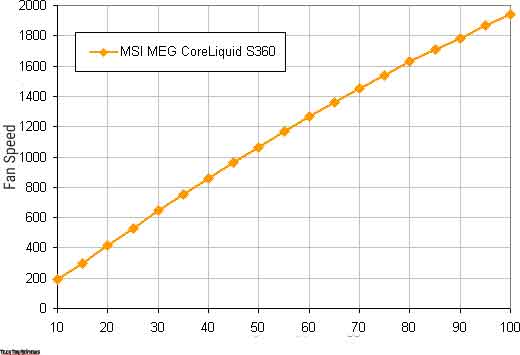
The range of rotation speed control is very wide, when the duty cycle (SC) changes from 10% to 100%, a smooth, near-linear increase of rotation speed occurs. Note that at 0% short-circuit (more precisely, 5% and below), the fans stop, which can be important in hybrid cooling systems with the idle mode at minimal load. Fans start with a short circuit of 10% or more.
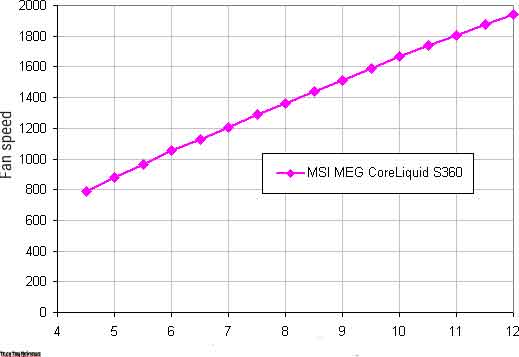
Speed change is also smooth, but the voltage adjustment range is very narrow. The fans stop at 4.2-4.3V and start at 4.3-4.4V. It is allowed to connect them to 5V if necessary, the rotation speed of the pump, also the fan on it can be adjusted bypassing the software, but it is definitely not easy. As a default, if you do not use the software, so the pump and the fan on it work at maximum speed.
Determining the dependence of processor temperature at full load on the rotational speed of the cooler fan
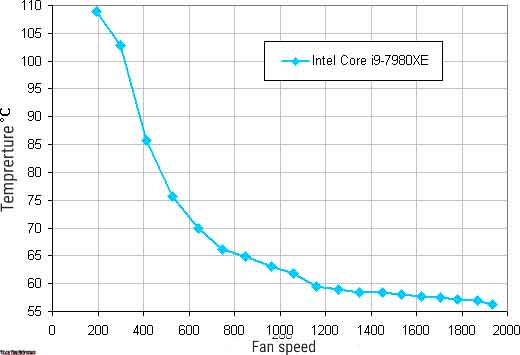
In this test, our processor with a TDP of 140 W already heats up (at 24 degrees of ambient air) at fan speed, when the short circuit is reduced to 15% or less, but it’s only at 300 rpm or less.
Determination of noise level based on the rotational speed of the cooler fan
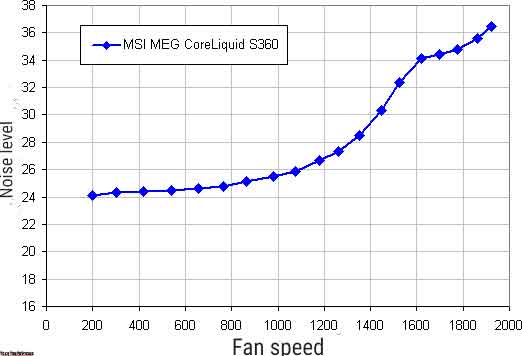
Of course, depending on individual characteristics and other factors, but somewhere over 40 dBA and higher, the noise, from our point of view, is too much for a desktop system; 35 to 40 dBA noise level is tolerated; below 35 dBA, noise from the cooling system won’t stand out much against the background of typical celestial PC components – case fans, fans on the power supply and video cards, as well as hard drives; and somewhere below 25 dBA, a cooler can be called conditional silent.
Plotting the dependence of the actual maximum power on the noise level
Let’s try to move from test bench conditions to more realistic scenarios. Let’s say that the air temperature taken by the cooling system fan can rise to 44 °C (a realistic scenario when the fans on the heatsink are set to exit a case that has a powerful video card running), but the processor temperature under maximum load does not want to rise above 80 ° C. Restricting myself to these terms, let us plot the dependence of the actual maximum power, denoted as p max (earlier we used the designation max. tdp), noise level consumed by the processor.
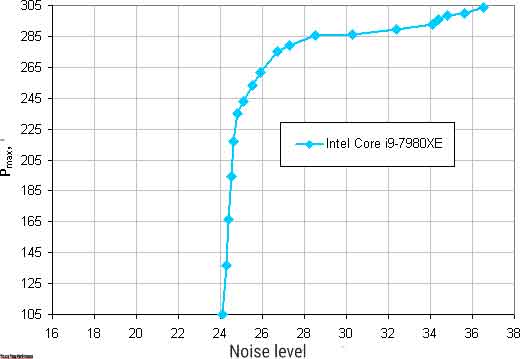
Taking 25 dBA as the conditional noiselessness criterion, we get the approximate maximum power of the processor corresponding to this level, which is about 240 watts. If you ignore the noise level, so the power limit can be increased to 305 watts elsewhere. Once again, we will clarify that this is in the harsh conditions of blowing the radiator with air heated to 44 degrees, indicated power limit and maximum power increase for silent operation, with a decrease in air temperature. Note that if the user is using software to reduce the pump rotation speed, so while not reducing the cooling capacity too much, might reduce the noise level a bit.
As an additional test, we decided to see how this LSS would withstand the AMD Ryzen 9 3950X. The Ryzen 9 family processors are an assembly of three crystals under a cover. Aside, from increasing the area from which heat is removed, the cooling capacity of the cooler can be improved, but on the other hand, the design of most coolers is optimized for better cooling of the central area of the processor.
Dependence of processor temperature at full load on fan speed:
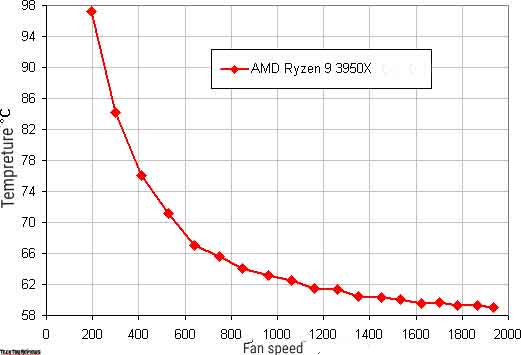
Actually, under test conditions, this processor heats up to 24 degrees of ambient air at a short circuit of 10%, which corresponds to only 190 rpm (for this CPU, heating up to 95 degrees is allowed).
Restricting myself to the above conditions, we will plot the dependence of the actual maximum power (denoted as P max) consumed by the processor on the noise level:
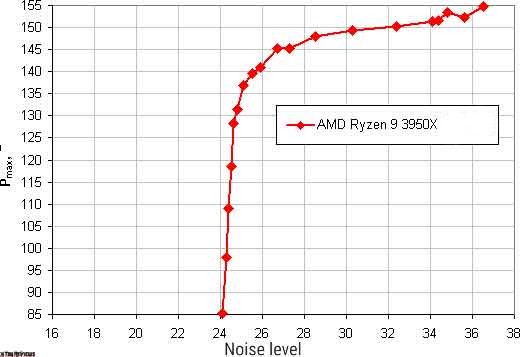
Taking 25 dBA as the conditional noiselessness criterion, we find that the maximum processor power corresponding to this level is about 135 W. If you ignore the noise level, the power limit can be increased to somewhere around 155 watts. Let us clarify once again: this is in the harsh conditions of blowing up the radiator with air heated to 44 degrees. As the ambient temperature decreases, specified power range for quiet operation and maximum power surge. The result is quite poor in terms of the Intel Core i9-7980XE processor. However, provided that the case has adequate ventilation, this cooler will withstand quite a bit of cooling of the AMD Ryzen 9 3950X processor, but you should not count on the possibility of significant overclocking.
Final line
Based on the MSI MEG CoreLiquid S360 liquid cooling system, you can make a relatively silent computer equipped with an Intel Core i7-6900K processor (LGA 2011, Broadwell-E) with maximum heat dissipation of about 240 W, and this is also taking into account the possible increase in temperature inside the case to 44 ° C and subject to long-term maximum load.
In the case of the AMD Ryzen 9 3950X chipset processor, the efficiency of the cooler is quite low, and to comply with the above conditions, the maximum power consumed by the processor should not exceed 135 W.
With lower cooling air temperatures and/or less stringent noise requirements, the power limit can be increased. In addition, the noise level can be reduced with little or no consequence by marginally reducing the pump speed. The LCD screen on the pump can not only decorate the internal space of the system unit but also bring some benefits,
Thereby helping the user to keep track of the current PC parameters and the weather outside the window. We have good workmanship, convenient fastening of water blocks, pay attention to parts of the braided hoses and cables, as well as a fan on the pump, which is designed to cool the VRM and other components around the processor.
MSI MEG CoreLiquid S360 price and availability
- MSI MEG CoreLiquid S360 AIO CPU Liquid Cooler has been priced at $279.99, and it can be purchased via Amazon.com, Amazon.co.uk, Bhphotovideo.com, and Adorama.com websites.
- MSI MEG CoreLiquid S280 AIO CPU Liquid Cooler has been priced at $249.99, and it can be purchased via Amazon.com, Bhphotovideo.com, and Adorama.com websites.
